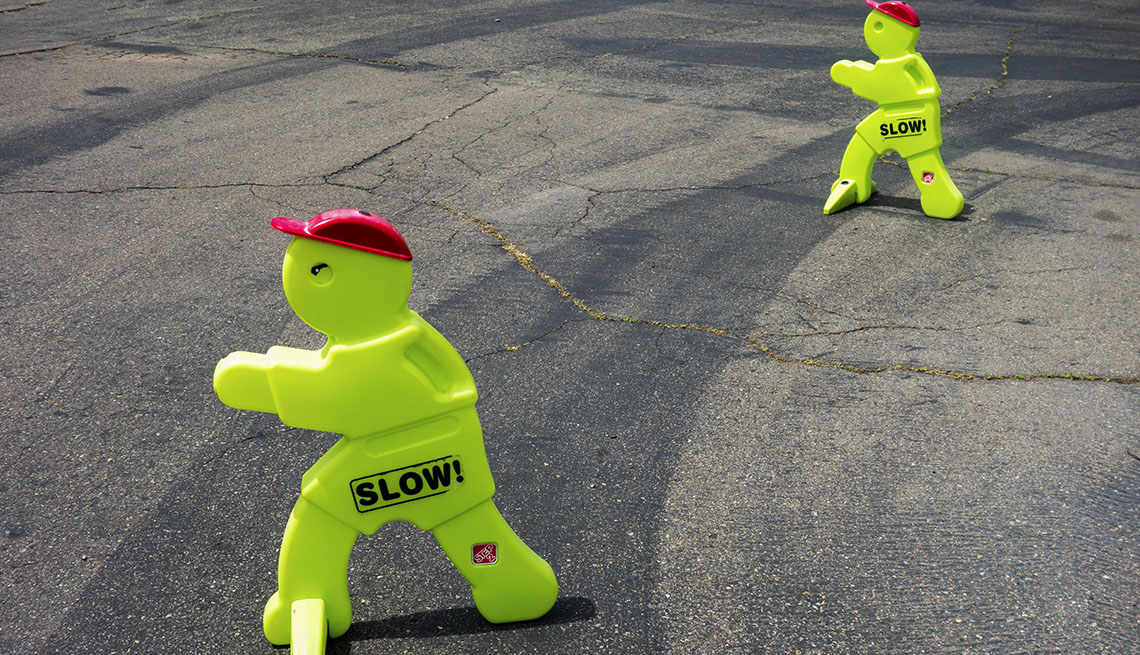11 vision zero solutions for safer streets
11 vision zero solutions for safer streets"
- Select a language for the TTS:
- UK English Female
- UK English Male
- US English Female
- US English Male
- Australian Female
- Australian Male
- Language selected: (auto detect) - EN
Play all audios:
1. REDUCE THE NUMBER OF TRAVEL LANES Downsizing four-lane roadways to two travel lanes with an alternating turn lane in the middle has become a popular trend across the country. When this
"road diet" approach was used on a stretch of Edgewater Boulevard in Orlando, crashes declined 34 percent and injuries 68 percent, while drivers' travel times actually
decreased. This explains why the Federal Highway Administration (FHWA) designates road diets as among the Proven Safety Countermeasures it suggests traffic engineers use to reduce collisions
at intersections. 2. REDUCE THE WIDTH OF TRAVEL LANES Wide lanes invite speeding while narrower lanes send a better message to drivers, says walkable communities expert Mark Fenton, a
former member the U.S. national racewalking team. 3. REDUCE THE CROSSING DISTANCE AT INTERSECTIONS A shorter walk across the street is a safer one. Extending the sidewalk out a few feet into
the intersection improves safety for all road users by making pedestrians more visible and slowing the speed of turning traffic. 4. MAKE CROSSWALKS MORE VISIBLE Mark them with bright swaths
of paint or, better yet, elevate them to curb level, which is a technique that has worked in places as varied as downtown San Francisco to rural Harrisonburg, Virginia. 5. ADD MEDIANS OR
PEDESTRIAN ISLANDS IN THE MIDDLE OF BUSY STREETS Medians and islands that provide a refuge for people crossing the street have been shown to reduce traffic accidents by 46 percent. The
Federal Highway Administration deems this one of its nine Proven Safety Countermeasures. 6. GIVE PEDESTRIANS A HEAD START AT TRAFFIC LIGHTS A three- to seven-second head start allows
pedestrians to enter the crosswalk first, making them more visible to motorists. This results in up to 60 percent fewer pedestrian-vehicle collisions, according to the National Association
of City Transportation Officials. 7. BAN RIGHT TURNS ON RED AT BUSY INTERSECTIONS Drivers, stopped at the red light and busy watching out for other cars, often don’t see people crossing the
street on green lights. Best option: Prohibit them at high-traffic intersections and streets. For instance, right turns on red are not allowed in New York City. 8. INSTALL TRAFFIC CALMING
MEASURES Roundabouts, speed humps and other traffic calming solutions remind motorists to drive slower and keep an eye out for people on foot. Roundabouts (another FHWA safety
countermeasure) added to La Jolla Boulevard in San Diego led to more people walking, the creation of new businesses, more on-street parking and shorter travel times for motorists. 9. CONVERT
ONE-WAY STREETS TO TWO-WAY Two way streets encourage safer, slower driving and less noise for local residents. Tampa, Dallas, Louisville and San Jose are among the cities changing streets
back to two-way. 10. INSTALL RED LIGHT CAMERAS It's expensive to station a police car at every unsafe intersection, but cameras can nab lawbreakers who speed, run red lights or don’t
yield to people walking. More than 550 communities from Sacramento to Charlotte now use red light cameras. 11. CREATE AND ENFORCE STRICTER TRAFFIC LAWS Killing or injuring people with a car
is no less tragic than doing it with a weapon. Seattle won top honors as a Walk Friendly Community, in part, for its Aggressive Driver Response Team where neighborhoods work with police to
curb dangerous drivers. "These pedestrian improvements typically improve motorists' and bicyclists' safety," says Charlie Zegeer, director of the Pedestrian and Bicycle
Information Center at the University of North Carolina. "It's a win-win-win. Everyone's safer." _Jay Walljasper is a writer, speaker and consultant on making our
communities great places for everyone and author of The Great Neighborhood Book. _ _Page published July 2015_ RELATED ARTICLES More from AARP.org/Livable Use the dropdown to choose a
livability topic. Select a Subject
Trending News
404 errorFête des Voisins: 10 million neighbours in France to meet this Friday 2025 marks the 25th edition of solidarity festival...
Attach mallya’s properties to pmla case: delhi courtOn 9 July, the court had cancelled the exemption from personal appearance granted to Mallya on an application of the ED ...
Explained | What is the state of Russian and US diplomatic missions?Newsletters ePaper Sign in HomeIndiaKarnatakaOpinionWorldBusinessSportsVideoEntertainmentDH SpecialsOperation SindoorNew...
Stop rats in your garden in may by not leaving one common item outside at nightRATS CAN BE A HUGE PROBLEM IN GARDENS AND CAN EVEN GET INTO HOMES IF THEY ARE ALLOWED TO BREED UNCONTROLLABLY KATHERINE ...
Malaysia: statutory declaration for marriage if you are divorcedForm MALAYSIA: STATUTORY DECLARATION FOR MARRIAGE IF YOU ARE DIVORCED Declaration confirming that there are no legal rea...
Latests News
11 vision zero solutions for safer streets1. REDUCE THE NUMBER OF TRAVEL LANES Downsizing four-lane roadways to two travel lanes with an alternating turn lane in ...
Penn state researchers discover the origins of genomic "dark matter"_In a newly published study, researchers from Penn State University detail the discovery of the origins of genomic “dark...
What should you do if your vehicle breaks down on a french motorway?THERE ARE SPECIFIC RULES TO BE AWARE OF SUCH AS NOT CONTACTING YOUR INSURANCE PROVIDER FOR BREAKDOWN ASSISTANCE When you...
The page you were looking for doesn't exist.You may have mistyped the address or the page may have moved.By proceeding, you agree to our Terms & Conditions and our ...
The unexpected power of weak tiesFinding a job depends in part on your social network, but the nature of social networks has changed. Now that we connect...
